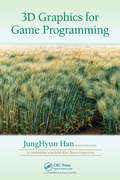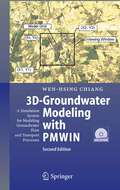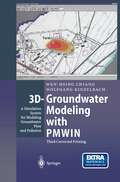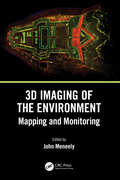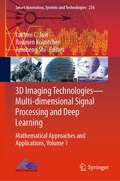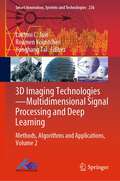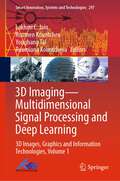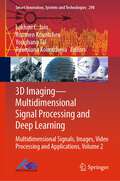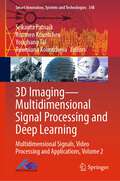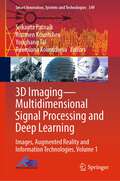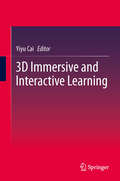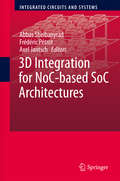- Table View
- List View
3D Graphics for Game Programming
by JungHyun HanDesigned for advanced undergraduate and beginning graduate courses, 3D Graphics for Game Programming presents must-know information for success in interactive graphics. Assuming a minimal prerequisite understanding of vectors and matrices, it also provides sufficient mathematical background for game developers to combine their previous experie
3d Graphics Rendering Cookbook: A Comprehensive Guide To Exploring Rendering Algorithms In Modern Opengl And Vulkan
by Viktor Latypov Sergey KosarevskyA comprehensive guide to exploring rendering algorithms in modern OpenGL and Vulkan
3D-Groundwater Modeling with PMWIN: A Simulation System for Modeling Groundwater Flow and Transport Processes
by Wen-Hsing ChiangThis book offer a complete simulation system for modeling groundwater flow and transport processes. The companion full-version software (PMWIN) comes with a professional graphical user-interface, supported models and programs and several other useful modeling tools. Tools include a Presentation Tool, a Result Extractor, a Field Interpolator, a Field Generator, a Water Budget Calculator and a Graphic Viewer. Book targeted at novice and experienced groundwater modelers.
3D-Groundwater Modeling with PMWIN: A Simulation System for Modeling Groundwater Flow and Pollution
by Wen-Hsing Chiang Wolfgang KinzelbachThis book and CD-ROM offer a complete simulation system for modeling groundwater flow and transport processes. The companion full-version software (PMWIN) comes with a professional graphical user-interface, supported models and programs and several other useful modeling tools. Tools include a Presentation Tool, a Result Extractor, a Field Interpolator, a Field Generator, a Water Budget Calculator and a Graphic Viewer. Book and CD-ROM are targeted at novice and experienced groundwater modelers.
3D IC and RF SiPs: Advanced Stacking And Planar Solutions For 5g Mobility (Wiley - IEEE)
by Lih-Tyng Hwang Tzyy-Sheng Jason HorngAn interdisciplinary guide to enabling technologies for 3D ICs and 5G mobility, covering packaging, design to product life and reliability assessments Features an interdisciplinary approach to the enabling technologies and hardware for 3D ICs and 5G mobility Presents statistical treatments and examples with tools that are easily accessible, such as Microsoft’s Excel and Minitab Fundamental design topics such as electromagnetic design for logic and RF/passives centric circuits are explained in detail Provides chapter-wise review questions and powerpoint slides as teaching tools
3D IC and RF SiPs: Advanced Stacking and Planar Solutions for 5G Mobility (Wiley - IEEE)
by Lih-Tyng Hwang Tzyy-Sheng Jason HorngAn interdisciplinary guide to enabling technologies for 3D ICs and 5G mobility, covering packaging, design to product life and reliability assessments Features an interdisciplinary approach to the enabling technologies and hardware for 3D ICs and 5G mobility Presents statistical treatments and examples with tools that are easily accessible, such as Microsoft’s Excel and Minitab Fundamental design topics such as electromagnetic design for logic and RF/passives centric circuits are explained in detail Provides chapter-wise review questions and powerpoint slides as teaching tools
3D Images of Materials Structures: Processing and Analysis
by Joachim Ohser Katja SchladitzTaking and analyzing images of materials' microstructures is essential for quality control, choice and design of all kind of products. Today, the standard method still is to analyze 2D microscopy images. But, insight into the 3D geometry of the microstructure of materials and measuring its characteristics become more and more prerequisites in order to choose and design advanced materials according to desired product properties. This first book on processing and analysis of 3D images of materials structures describes how to develop and apply efficient and versatile tools for geometric analysis and contains a detailed description of the basics of 3d image analysis.
3D Imaging of the Environment: Mapping and Monitoring
by John MeneelyThis is a comprehensive, overarching, interdisciplinary book and a valuable contribution to a unified view of visualisation, imaging, and mapping. It covers a variety of modern techniques, across an array of spatial scales, with examples of how to map, monitor, and visualise the world in which we live. The authors give detailed explanations of the techniques used to map and monitor the built and natural environment and how that data, collected from a wide range of scales and cost options, is translated into an image or visual experience. It is written in a way that successfully reaches technical, professional, and academic readers alike, particularly geographers, architects, geologists, and planners. FEATURES Includes in-depth discussion on 3D image processing and modeling Focuses on the 3D application of remote sensing, including LiDAR and digital photography acquired by UAS and terrestrial techniques Introduces a broad range of data collection techniques and visualisation methods Includes contributions from outstanding experts and interdisciplinary teams involved in earth sciences Presents an open access chapter about the EU-funded CHERISH Project, detailing the development of a toolkit for the 3D documentation and analysis of the combined coastline shared between Ireland and Wales Intended for those with a background in the technology involved with imaging and mapping, the contributions shared in this book introduce readers to new and emerging 3D imaging tools and programs.
3D Imaging of the Environment: Mapping and Monitoring
This is a comprehensive, overarching, interdisciplinary book and a valuable contribution to a unified view of visualisation, imaging, and mapping. It covers a variety of modern techniques, across an array of spatial scales, with examples of how to map, monitor, and visualise the world in which we live. The authors give detailed explanations of the techniques used to map and monitor the built and natural environment and how that data, collected from a wide range of scales and cost options, is translated into an image or visual experience. It is written in a way that successfully reaches technical, professional, and academic readers alike, particularly geographers, architects, geologists, and planners. FEATURES Includes in-depth discussion on 3D image processing and modeling Focuses on the 3D application of remote sensing, including LiDAR and digital photography acquired by UAS and terrestrial techniques Introduces a broad range of data collection techniques and visualisation methods Includes contributions from outstanding experts and interdisciplinary teams involved in earth sciences Presents an open access chapter about the EU-funded CHERISH Project, detailing the development of a toolkit for the 3D documentation and analysis of the combined coastline shared between Ireland and Wales Intended for those with a background in the technology involved with imaging and mapping, the contributions shared in this book introduce readers to new and emerging 3D imaging tools and programs.
3D Imaging Technologies in Atherosclerosis
by Rikin Trivedi Luca Saba Jasjit S. SuriAtherosclerosis represents the leading cause of mortality and morbidity in the world. Two of the most common, severe, diseases that may occur, acute myocardial infarction and stroke, have their pathogenesis in the atherosclerosis that may affect the coronary arteries as well as the carotid/intra-cranial vessels. Therefore, in the past there was an extensive research in identifying pre-clinical atherosclerotic diseases in order to plan the correct therapeutical approach before the pathological events occur. In the last 20 years imaging techniques and in particular Computed Tomography and Magnetic Resonance had a tremendous improvement in their potential. In the field of the Computed Tomography the introduction of the multi-detector-row technology and more recently the use of dual energy and multi-spectral imaging provides an exquisite level of anatomic detail. The MR thanks to the use of strength magnetic field and extremely advanced sequences can image human vessels very quickly while offering an outstanding contrast resolution.
3D Imaging Technologies—Multi-dimensional Signal Processing and Deep Learning: Mathematical Approaches and Applications, Volume 1 (Smart Innovation, Systems and Technologies #234)
by Lakhmi C. Jain Roumen Kountchev Junsheng ShiThis book presents high-quality research in the field of 3D imaging technology. The second edition of International Conference on 3D Imaging Technology (3DDIT-MSP&DL) continues the good traditions already established by the first 3DIT conference (IC3DIT2019) to provide a wide scientific forum for researchers, academia and practitioners to exchange newest ideas and recent achievements in all aspects of image processing and analysis, together with their contemporary applications. The conference proceedings are published in 2 volumes. The main topics of the papers comprise famous trends as: 3D image representation, 3D image technology, 3D images and graphics, and computing and 3D information technology. In these proceedings, special attention is paid at the 3D tensor image representation, the 3D content generation technologies, big data analysis, and also deep learning, artificial intelligence, the 3D image analysis and video understanding, the 3D virtual and augmented reality, and many related areas. The first volume contains papers in 3D image processing, transforms and technologies. The second volume is about computing and information technologies, computer images and graphics and related applications. The two volumes of the book cover a wide area of the aspects of the contemporary multidimensional imaging and the related future trends from data acquisition to real-world applications based on various techniques and theoretical approaches.
3D Imaging Technologies—Multidimensional Signal Processing and Deep Learning: Methods, Algorithms and Applications, Volume 2 (Smart Innovation, Systems and Technologies #236)
by Lakhmi C. Jain Roumen Kountchev Yonghang TaiThis book presents high-quality research in the field of 3D imaging technology. The second edition of International Conference on 3D Imaging Technology (3DDIT-MSP&DL) continues the good traditions already established by the first 3DIT conference (IC3DIT2019) to provide a wide scientific forum for researchers, academia and practitioners to exchange newest ideas and recent achievements in all aspects of image processing and analysis, together with their contemporary applications. The conference proceedings are published in 2 volumes. The main topics of the papers comprise famous trends as: 3D image representation, 3D image technology, 3D images and graphics, and computing and 3D information technology. In these proceedings, special attention is paid at the 3D tensor image representation, the 3D content generation technologies, big data analysis, and also deep learning, artificial intelligence, the 3D image analysis and video understanding, the 3D virtual and augmented reality, and many related areas. The first volume contains papers in 3D image processing, transforms and technologies. The second volume is about computing and information technologies, computer images and graphics and related applications. The two volumes of the book cover a wide area of the aspects of the contemporary multidimensional imaging and the related future trends from data acquisition to real-world applications based on various techniques and theoretical approaches.
3D Imaging—Multidimensional Signal Processing and Deep Learning: 3D Images, Graphics and Information Technologies, Volume 1 (Smart Innovation, Systems and Technologies #297)
by Lakhmi C. Jain Roumen Kountchev Yonghang Tai Roumiana KountchevaThis book gathers selected papers presented at the conference “Advances in 3D Image and Graphics Representation, Analysis, Computing and Information Technology,” one of the first initiatives devoted to the problems of 3D imaging in all contemporary scientific and application areas. The two volumes of the book cover wide area of the aspects of the contemporary multidimensional imaging and outline the related future trends from data acquisition to real-world applications based on new techniques and theoretical approaches. This volume contains papers devoted to the theoretical representation and analysis of the 3D images. The related topics included are 3D image transformation, 3D tensor image representation, 3D content generation technologies, 3D graphic information processing, VR content generation technologies, multi-dimensional image processing, dynamic and auxiliary 3D displays, VR/AR/MR device, VR camera technologies, 3D imaging technologies and applications, 3D computer vision, 3D video communications, 3D medical images processing and analysis, 3D remote sensing images and systems, deep learning for image restoration and recognition, neural networks for MD image processing, etc.
3D Imaging—Multidimensional Signal Processing and Deep Learning: Multidimensional Signals, Images, Video Processing and Applications, Volume 2 (Smart Innovation, Systems and Technologies #298)
by Lakhmi C. Jain Roumen Kountchev Yonghang Tai Roumiana KountchevaThis book gathers selected papers presented at the conference “Advances in 3D Image and Graphics Representation, Analysis, Computing and Information Technology,” one of the first initiatives devoted to the problems of 3D imaging in all contemporary scientific and application areas. The two volumes of the book cover wide area of the aspects of the contemporary multidimensional imaging and outline the related future trends from data acquisition to real-world applications based on new techniques and theoretical approaches. This volume contains papers aimed at the multidimensional systems and signal processing, deep learning, mathematical approaches and the related applications. The related topics are multidimensional multi-component image processing; multidimensional image representation and super-resolution; compression of multidimensional spatio-temporal images; multidimensional image transmission systems; multidimensional signal processing; prediction and filtering of multidimensional process; intelligent multi-spectral and hyper-spectral image processing, intelligent multi-view image processing, 3D deep learning, 3D GIS and graphic database; data-based MD image retrieval and knowledge data mining; watermarking, hiding and encryption of MD images; intelligent visualization of MD images; forensic analysis systems for M3D graphics algorithm; 3D VR (Virtual Reality)/AR (Augmented Reality); applications of multidimensional signal processing; applications of multidimensional systems; multidimensional filters and filter-banks.
3D Imaging—Multidimensional Signal Processing and Deep Learning: Multidimensional Signals, Video Processing and Applications, Volume 2 (Smart Innovation, Systems and Technologies #348)
by Srikanta Patnaik Roumen Kountchev Yonghang Tai Roumiana KountchevaThis book presents high-quality research in the field of 3D imaging technology. The fourth edition of International Conference on 3D Imaging Technology (3DDIT-MSP&DL) continues the good traditions already established by the first three editions of the conference to provide a wide scientific forum for researchers, academia and practitioners to exchange newest ideas and recent achievements in all aspects of image processing and analysis, together with their contemporary applications. The conference proceedings are published in 2 volumes. The main topics of the papers comprise famous trends as: 3D image representation, 3D image technology, 3D images and graphics, and computing and 3D information technology. In these proceedings, special attention is paid at the 3D tensor image representation, the 3D content generation technologies, big data analysis, and also deep learning, artificial intelligence, the 3D image analysis and video understanding, the 3D virtual and augmented reality, and many related areas. The first volume contains papers in 3D image processing, transforms and technologies. The second volume is about computing and information technologies, computer images and graphics and related applications. The two volumes of the book cover a wide area of the aspects of the contemporary multidimensional imaging and the related future trends from data acquisition to real-world applications based on various techniques and theoretical approaches.
3D Imaging—Multidimensional Signal Processing and Deep Learning: Images, Augmented Reality and Information Technologies, Volume 1 (Smart Innovation, Systems and Technologies #349)
by Srikanta Patnaik Roumen Kountchev Yonghang Tai Roumiana KountchevaThis book presents high-quality research in the field of 3D imaging technology. The fourth edition of International Conference on 3D Imaging Technology (3DDIT-MSP&DL) continues the good traditions already established by the first three editions of the conference to provide a wide scientific forum for researchers, academia, and practitioners to exchange newest ideas and recent achievements in all aspects of image processing and analysis, together with their contemporary applications. The conference proceedings are published in two volumes. The main topics of the papers comprise famous trends as: 3D image representation, 3D image technology, 3D images and graphics, and computing and 3D information technology. In these proceedings, special attention is paid at the 3D tensor image representation, the 3D content generation technologies, big data analysis, and also deep learning, artificial intelligence, the 3D image analysis and video understanding, the 3D virtual and augmented reality, and many related areas. The first volume contains papers in 3D image processing, transforms, and technologies. The second volume is about computing and information technologies, computer images and graphics and related applications. The two volumes of the book cover a wide area of the aspects of the contemporary multidimensional imaging and the related future trends from data acquisition to real-world applications based on various techniques and theoretical approaches.
3D Immersive and Interactive Learning
by Yiyu Cai3D technology is not new; research on 3D started back in early 1960s. But unlike in previous times, 3D technology has now rapidly entered our daily life from cinema to office to home. Using 3D for education is a new yet challenging task. This book will present several innovative efforts using 3D for immersive and interactive learning covering a wide spectrum of education including gifted program, normal (technical) stream, and special needs education. The book will also share experience on curriculum-based 3D learning in classroom setting and co-curriculum-based 3D student research projects. The book is organized as follows. Chapter 1 introduces the fundamentals of 3D educational technology and their applications in immersive and interactive learning. Chapter 2 discusses the use of virtual reality in teaching and learning of Molecular Biology. Chapter 3 presents the daVinci Lab @ River Valley High School. Chapter 4 describes the 3D education development process. Chapter 5 studies the adaption 3D system for learning gains in lower secondary normal (technical) stream. Chapter 6 investigates the effects of virtual reality technology on spatial visualization skills. Chapter 7 showcases a sabbatical program for students to use 3D for Science, Technology, Engineering and Mathematics (STEM) learning. Chapter 8 shares the use of 3D virtual pink dolphin to assist special education. The foreword of this book is written by Dr Cheah Horn Mun, Director, Education Technology Division, Ministry of Education, Singapore.
3D Industrial Printing with Polymers
by Johannes Karl Fink3D industrial printing has become mainstream in manufacturing. This unique book is the first to focus on polymers as the printing material. The scientific literature with respect to 3D printing is collated in this monograph. The book opens with a chapter on foundational issues such and presents a broad overview of 3D printing procedures and the materials used therein. In particular, the methods of 3d printing are discussed and the polymers and composites used for 3d printing are detailed. The book details the main fields of applications areas which include electric and magnetic uses, medical applications, and pharmaceutical applications. Electric and magnetic uses include electronic materials, actuators, piezoelectric materials, antennas, batteries and fuel cells. Medical applications are organ manufacturing, bone repair materials, drug-eluting coronary stents, and dental applications. The pharmaceutical applications are composite tablets, transdermal drug delivery, and patient-specific liquid capsules. A special chapter deals with the growing aircraft and automotive uses for 3D printing, such as with manufacturing of aircraft parts and aircraft cabins. In the field of cars, 3D printing is gaining importance for automotive parts (brake components, drives), for the fabrication of automotive repair systems, and even 3D printed vehicles.
3D Integration for NoC-based SoC Architectures (Integrated Circuits and Systems)
by Abbas Sheibanyrad Frédéric Pétrot Axel JantschThis book presents the research challenges that are due to the introduction of the 3rd dimension in chips for researchers and covers the whole architectural design approach for 3D-SoCs. Nowadays the 3D-Integration technologies, 3D-Design techniques, and 3D-Architectures are emerging as interesting, truly hot, broad topics. The present book gathers the recent advances in the whole domain by renowned experts in the field to build a comprehensive and consistent book around the hot topics of three-dimensional architectures and micro-architectures. This book includes contributions from high level international teams working in this field.
3D Integration for VLSI Systems
by Chuan Seng Tan Kuan-Neng Chen Steven J. KoesterThree-dimensional (3D) integration is identified as a possible avenue for continuous performance growth in integrated circuits (IC) as the conventional scaling approach is faced with unprecedented challenges in fundamental and economic limits. Wafer level 3D IC can take several forms, and they usually include a stack of several thinned IC layers th
3D Integration for VLSI Systems
by Chuan Seng Tan Kuan-Neng Chen Steven J. KoesterThree-dimensional (3D) integration is identified as a possible avenue for continuous performance growth in integrated circuits (IC) as the conventional scaling approach is faced with unprecedented challenges in fundamental and economic limits. Wafer level 3D IC can take several forms, and they usually include a stack of several thinned IC layers th
3D Integration in VLSI Circuits: Implementation Technologies and Applications (Devices, Circuits, and Systems)
by Katsuyuki Sakuma and Krzysztof IniewskiCurrently, the term 3D integration includes a wide variety of different integration methods, such as 2.5-dimensional (2.5D) interposer-based integration, 3D integrated circuits (3D ICs), 3D systems-in-package (SiP), 3D heterogeneous integration, and monolithic 3D ICs. The goal of this book is to provide readers with an understanding of the latest challenges and issues in 3D integration. TSVs are not the only technology element needed for 3D integration. There are numerous other key enabling technologies required for 3D integration, and the speed of the development in this emerging field is very rapid. To provide readers with state-of-the-art information on 3D integration research and technology developments, each chapter has been contributed by some of the world’s leading scientists and experts from academia, research institutes, and industry from around the globe. Covers chip/wafer level 3D integration technology, memory stacking, reconfigurable 3D, and monolithic 3D IC. Discusses the use of silicon interposer and organic interposer. Presents architecture, design, and technology implementations for 3D FPGA integration. Describes oxide bonding, Cu/SiO2 hybrid bonding, adhesive bonding, and solder bonding. Addresses the issue of thermal dissipation in 3D integration.
3D Integration in VLSI Circuits: Implementation Technologies and Applications (Devices, Circuits, and Systems)
by Katsuyuki SakumaCurrently, the term 3D integration includes a wide variety of different integration methods, such as 2.5-dimensional (2.5D) interposer-based integration, 3D integrated circuits (3D ICs), 3D systems-in-package (SiP), 3D heterogeneous integration, and monolithic 3D ICs. The goal of this book is to provide readers with an understanding of the latest challenges and issues in 3D integration. TSVs are not the only technology element needed for 3D integration. There are numerous other key enabling technologies required for 3D integration, and the speed of the development in this emerging field is very rapid. To provide readers with state-of-the-art information on 3D integration research and technology developments, each chapter has been contributed by some of the world’s leading scientists and experts from academia, research institutes, and industry from around the globe. Covers chip/wafer level 3D integration technology, memory stacking, reconfigurable 3D, and monolithic 3D IC. Discusses the use of silicon interposer and organic interposer. Presents architecture, design, and technology implementations for 3D FPGA integration. Describes oxide bonding, Cu/SiO2 hybrid bonding, adhesive bonding, and solder bonding. Addresses the issue of thermal dissipation in 3D integration.
3D Integration of Resistive Switching Memory (Frontiers in Semiconductor Technology)
by Qing LuoThis book offers a thorough exploration of the three-dimensional integration of resistive memory in all aspects, from the materials, devices, array-level issues, and integration structures to its applications. Resistive random-access memory (RRAM) is one of the most promising candidates for next-generation nonvolatile memory applications owing to its superior characteristics including simple structure, high switching speed, low power consumption, and compatibility with standard complementary metal oxide semiconductor (CMOS) process. To achieve large-scale, high-density integration of RRAM, the 3D cross array is undoubtedly the ideal choice. This book introduces the 3D integration technology of RRAM, and breaks it down into five parts: 1: Associative Problems in Crossbar array and 3D architectures;2: Selector Devices and Self-Selective Cells; 3: Integration of 3D RRAM; 4: Reliability Issues in 3D RRAM; 5: Applications of 3D RRAM beyond Storage.The book aspires to provide a relevant reference for students, researchers, engineers, and professionals working with resistive random-access memory or those interested in 3D integration technology in general.
